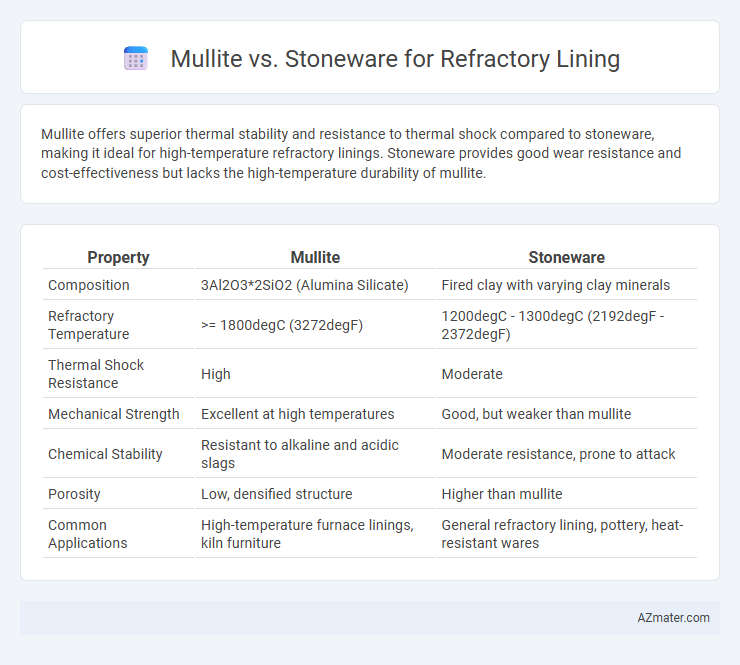Mullite offers superior thermal stability and resistance to thermal shock compared to stoneware, making it ideal for high-temperature refractory linings. Stoneware provides good wear resistance and cost-effectiveness but lacks the high-temperature durability of mullite.
Table of Comparison
| Property | Mullite | Stoneware |
|---|---|---|
| Composition | 3Al2O3*2SiO2 (Alumina Silicate) | Fired clay with varying clay minerals |
| Refractory Temperature | >= 1800degC (3272degF) | 1200degC - 1300degC (2192degF - 2372degF) |
| Thermal Shock Resistance | High | Moderate |
| Mechanical Strength | Excellent at high temperatures | Good, but weaker than mullite |
| Chemical Stability | Resistant to alkaline and acidic slags | Moderate resistance, prone to attack |
| Porosity | Low, densified structure | Higher than mullite |
| Common Applications | High-temperature furnace linings, kiln furniture | General refractory lining, pottery, heat-resistant wares |
Introduction to Refractory Lining Materials
Refractory lining materials such as mullite and stoneware are critical for high-temperature industrial applications, offering excellent thermal stability and resistance to abrasion. Mullite, an alumino-silicate ceramic with high alumina content, provides superior thermal shock resistance and mechanical strength compared to stoneware, which is typically composed of dense clay and silica, known for its cost-effectiveness and moderate durability. Selecting between mullite and stoneware depends on operational temperature, chemical environment, and mechanical stress requirements in refractory lining systems.
What is Mullite? Properties and Formation
Mullite is a crystalline aluminosilicate mineral (3Al2O3*2SiO2) known for its exceptional thermal stability, low thermal expansion, and high mechanical strength, making it ideal for refractory linings. It forms through the high-temperature reaction of alumina (Al2O3) and silica (SiO2) during firing processes or naturally in contact metamorphic rocks. Mullite's unique needle-like crystal structure provides excellent resistance to thermal shock, chemical corrosion, and slag attack, outperforming traditional stoneware materials in refractory applications.
Understanding Stoneware: Key Characteristics
Stoneware is a dense, non-porous ceramic material characterized by its high strength and durability, making it resistant to thermal shock and mechanical wear in refractory linings. It typically contains a high percentage of alumina and silica, providing good chemical stability and heat resistance up to approximately 1200degC. Its cost-effectiveness and ease of fabrication make stoneware a practical choice for medium-temperature refractory applications compared to the more specialized mullite.
Thermal Performance: Mullite vs Stoneware
Mullite exhibits superior thermal performance compared to stoneware due to its higher melting point of approximately 1840degC and excellent thermal stability under extreme heat conditions. Stoneware typically withstands temperatures up to 1300degC, making mullite more suitable for refractory linings exposed to intense thermal cycling and high-temperature environments. The enhanced thermal shock resistance and lower thermal conductivity of mullite reduce heat loss and increase the lifespan of refractory linings in industrial furnaces and kilns.
Mechanical Strength Comparison
Mullite exhibits superior mechanical strength compared to stoneware, making it more suitable for high-stress refractory linings in industrial applications. With a higher modulus of rupture and enhanced resistance to thermal shock, mullite withstands mechanical wear and deformation under extreme temperatures more effectively than stoneware. Stoneware, while durable and cost-effective, typically demonstrates lower mechanical strength and is more prone to microcracking under mechanical loads in refractory environments.
Chemical Resistance: Suitability for Harsh Environments
Mullite exhibits superior chemical resistance compared to stoneware, making it highly suitable for refractory linings in harsh environments with aggressive slags and alkalis. Its stable aluminosilicate structure withstands corrosive gases and molten materials more effectively than stoneware, which is more prone to chemical degradation. This enhanced chemical durability of mullite ensures longer service life and reduced maintenance in extreme industrial applications.
Cost Considerations and Availability
Mullite refractories generally incur higher initial costs due to their superior thermal stability and durability, yet their extended lifespan can reduce long-term expenses in refractory lining applications. Stoneware materials offer more cost-effective options with easier availability and faster installation, making them suitable for less demanding environments where budget constraints are critical. Selecting between mullite and stoneware depends on balancing upfront investment against performance requirements and material accessibility in the specific industrial setting.
Installation and Maintenance Factors
Mullite offers superior thermal stability and low thermal expansion, simplifying installation with reduced risk of cracking in refractory linings compared to stoneware. Stoneware, while durable and cost-effective, requires careful handling during installation to prevent chipping and may demand more frequent maintenance due to its higher porosity. Maintenance of mullite linings typically involves less downtime and fewer repairs because of its enhanced resistance to thermal shock and chemical corrosion.
Typical Applications in Industry
Mullite is widely used in high-temperature furnace linings and kiln furniture due to its excellent thermal stability and resistance to thermal shock, making it ideal for glass manufacturing and metallurgical processes. Stoneware, characterized by its dense, non-porous structure and good mechanical strength, is commonly applied in chemical processing equipment and wastewater treatment plants where durability and chemical resistance are essential. Industries such as ceramics, cement production, and petrochemical refining rely on these refractory materials for their specific properties to optimize performance and longevity under extreme operating conditions.
Choosing the Right Material: Mullite or Stoneware?
Mullite offers superior thermal stability and resistance to chemical corrosion, making it ideal for high-temperature refractory linings in industrial kilns and furnaces. Stoneware, with its high density and toughness, provides excellent mechanical strength and abrasion resistance but performs best at moderate temperatures below 1300degC. Selecting between Mullite and Stoneware depends on specific operating conditions such as temperature range, chemical exposure, and mechanical stress to optimize lifespan and performance of the refractory lining.

Infographic: Mullite vs Stoneware for Refractory lining
 azmater.com
azmater.com